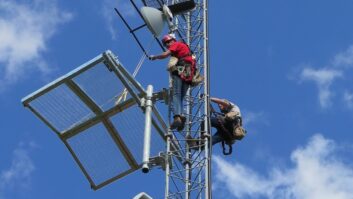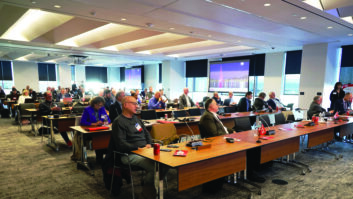It all started on a pleasant summer day.
I was driving along minding my own business in my hometown of Brainerd, Minn., when suddenly there it was: a new 180-foot wireless Internet tower at the Consolidated Telecommunications Co. building in the Brainerd Industrial Park.
It had all happened overnight, so to speak. One day there was nothing; the next day a crane had lifted the new tower into place for everyone to see.

The wireless tower has 700 MHz antennas, mounted near the top, that tilt down slightly to control the coverage area.
The tower is just 0.87 miles (1.4 km) west of the KLIZ(AM) three-tower directional antenna system. KLIZ operates on 1380 kHz, which makes the new Consolidated tower almost exactly one-quarter wavelength in height at KLIZ’s frequency.
KLIZ is one of my regular clients so I immediately went out to take AM directional monitor point readings.
The new tower had indeed become a significant re-radiator of the KLIZ signal. It was picking up and retransmitting KLIZ in a fashion that raised the field intensity levels in two nearby monitor points from a comfortable 50 percent of their limits to just at their limits. Ouch! I could even plainly see most of the Consolidated tower from one of the monitor points.
What to do
I went into the Consolidated building and asked for the manager. Fortunately we had met before; I was not some “nut” walking in the door claiming they’d ruined the world by putting up a tower.
The project manager, Bill Stroot, found my story interesting but mostly unbelievable.
How was he to know about AM directional antennas? He isn’t an RF guy, though he knows a little more now. Bill had done almost all of the proper research, making sure the tower was not near an airport or flight path and that it complied with all city building codes. He showed me an FCC license for the 700 MHz band wireless Internet facility. He inferred that if the FCC said it was OK, it shouldn’t be a problem!
Stroot finally agreed to do some homework while I went to my office to look up FCC Rule 73.1692, which I mentioned in an RW article a few months back. The rule about broadcast station construction near or installation on an AM broadcast tower reads:

The unipole detuning box sits at the center of the inside of the tower.
Where a broadcast licensee or permittee proposes to mount a broadcast antenna on an AM station tower, or where construction is proposed within 0.8 km of an AM nondirectional tower or within 3.2 km of an AM directional station, the broadcast licensee or permittee is responsible for ensuring that the construction does not adversely affect the AM station.
The Consolidated Telecommunications license is for an “area of coverage” and does not have any specifics on tower location or locations to accomplish the task. It all makes sense unless there is an AM tower nearby.
The FCC normally looks out for AM stations by issuing licenses or construction permits to two-way, cellular and other wireless facilities with “special operating conditions or restrictions” when they are near an AM. I wonder how many more of these “area” licenses slipped through the cracks at the FCC.
When we met again, Bill acknowledged that he had talked with someone else who had experienced a similar situation and that we should do something about this one. That something came to about $12,000, which Consolidated paid.
Consolidated is a cooperative telecommunications utility that started out as a rural telephone company many years ago. They seemed to have no serious problem finding money.
The project turned out to involve a unipole detuning system from Nott Ltd., tower climbers to install the unipole and me to tune (detune) it.
I tried something different on this one. The three near-vertical 145-foot unipole wires are on the “inside” of the tower rather than the outside. This was made possible because the tower is a self-supporting structure 22 feet across at the base. The unipole detuning box sits at the center of the inside of the tower. The vertical unipole wires turn horizontal at 8 feet above the ground and meet just above detuning box.

Bill Stroot stands near one of the unipole wires.
In the end
The project when smoothly and it worked as predicted to detune the tower. This made the structure electrically invisible at 1380 kHz so it would not pick up and re-radiate signal on that frequency. The KLIZ(AM) directional monitor points returned to normal and we all walked away smiling. Bill Stroot, now retired, is in one of the photos near one of the unipole wires so you can understand the size of the tower base.
A letter of agreement was drawn up between the radio station and Consolidated allowing reasonable access for checking the tuning of the unipole during regular business hours. Remember, things break!
Mark Persons WØMH is certified by the Society of Broadcast Engineers as a Professional Broadcast Engineer and has more than 30 years’ experience. His website is www.mwpersons.com.












